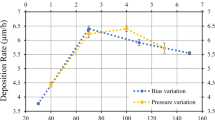Abstract
Stray corrosion is a common phenomenon that occurs at the surface adjacent to the machining area during electrochemical machining (ECM). It can cause unwanted metal removal and has a substantial effect on the ECM precision. Standard through-mask ECM prevents stray corrosion with a locally insulated anode, which requires the insulating material to be positioned accurately and applied through a complex process, including resist application, exposure, developing, and stripping. This paper presents a new method for reducing stray current attack by using an iron coating on the surface of the anode workpiece in NaNO3 solution. The application of the iron coating to the whole initial surface of the workpiece does not require precision, and the process is simple and economical. Because the iron coating is passivated at low current densities and can be easily applied or removed, it can be used to reduce the stray current attack. The η-i curves of the nickel-based alloy, Inconel 718, show that its dissolution efficiency is higher at low current densities, indicating poor localization and severe stray corrosion during ECM. A simulation and an experimental study of ECM a convex on iron-coated and uncoated Inconel 718 workpieces were performed. The results showed that the iron coating on the surface of the workpiece significantly improves the machining accuracy. It reduces stray corrosion and the amount of stray removal on the non-machined top surface of the convex workpiece.
Similar content being viewed by others
References
Ahn SH, Ryu SH, Choi DK, Chu CN (2004) Electro-chemical micro drilling using ultra short pulses. Precis Eng 28:129–134
Bannard J (1977) Effect of flow on the dissolution efficiency of mild steel during ECM. J Appl Electrochem 7:267–270
De Silva A, Altena HSJ, McGeough JA (2003) Influence of electrolyte concentration on copying accuracy of precision-ECM. Annals CIRP 52:165–8
Dhobe SD, Doloi B, Bhattacharyya B (2011) Surface characteristics of ECMed titanium work samples for biomedical applications. Int J Adv Manuf Technol 55:177–188
Fan ZW, Hourng LW, Lin MY (2012) Experimental investigation on the influence of electrochemical micro-drilling by short pulsed voltage. Int J Adv Manuf Technol 61:957–966
Fan ZJ, Wang GG, Tang L, Wang TC (2010) Design of device and experiment on magnetic field assisted electrochemical machining. Chin J Mech Eng 46:194–198
Fan ZJ, Zhang LX, Tang L (2008) Influence of magnetic field on accuracy of ECM by changing the conductivity of anode film. Chin J Mech Eng 21:11–14
Fang XL, Qu NS, Zhang YD, Xu ZY, Zhu D (2014) Improvement of hole exit accuracy in electrochemical drilling by applying a potential difference between an auxiliary electrode and the anode. J Mater Process Technol 214:556–564
Hoare JP, Chartrand AJ, La Boda MA (1973) Electrochemical machining of high-temperature alloys in NaClO3 solutions. J Electrochem Soc 120:1071–1077
Jain VK, Lal GK, Kanetkar Y (2005) Stray current attack and stagnation zones in electrochemical drilling. Int J Adv Manuf Technol 26:527–536
Ji H, Li ZY (2008) Experimental investigation on electrochemical finishing machining of stainless steel in passive electrolyte solution. Adv Mater Res 53–54:27–32
Laboda MA, Chartrand AJ, Hoare JP, Wiese CR, Mao KW (1973) ECM of nickel in NaClO3 solution. J Electrochem Soc 120:643–646
Lohrengel MM, Rosenkranz C (2005) Microelectrochemical surface and product investigations during electrochemical machining (ECM) in NaNO3. Corros Sci 47:785–794
Makino E, Motor N, Sato T (1983) Effects of cobalt on high rate dissolution behaviour of nickel-base superalloys in NaNO3 and NaCl solutions. Precis Eng 5:65–72
McCrabb H, Lozano-Morales A, Snyder S, Gebhart L, Taylor EJ (2009) Through mask electrochemical machining. J Electrochem Soc 19(26):19–33
McGeough JA, Pajak PT, De Silva A, Harrison DK (2003) Recent research and developments in electrochemical machining. Int J Electr Mach 8:1–14
Rajurkar KP, Zhu D, McGeough JA, Kozak J, De Silva A (1999) New developments of electro-chemical machining. Annals CIRP 48(2):567–579
Rosenkranz C, Lohrengel MM, Schultze JW (2005) The surface structure during pulsed ECM of iron in NaNO3. Electrochim Acta 50:2009–2016
Tang L, Gan WM (2014) Experiment and simulation study on concentrated magnetic field-assisted ECM S-03 special stainless steel complex cavity. Int J Adv Manuf Technol 72:685–692
Venkata Rao R, Kalyankar VD (2014) Optimization of modern machining processes using advanced optimization techniques: a review. Int J Adv Manuf Technol 73:1159–1188
Wang L, Wang QD, Hao XQ, Ding YC, Lu BH (2010) Finite element simulation and experimental study on the through-mask electrochemical micromachining (EMM) process. Int J Adv Manuf Technol 51:155–162
Wang SH, Zeng YB, Liu Y, Zhu D (2012) Micro wire electrochemical machining with an axial electrolyte flow. Int J Adv Manuf Technol 63:25–32
Yu CY, Yang YS, Cheng CK, Peklenik J (1981) The relation between copying accuracy and electrolytes of electrochemical machining for titanium alloys. Manuf Technol 30:123–127
Zhu D, Xu HY (2002) Improvement of electrochemical machining accuracy by using dual pole tool. J Mater Process Technol 129:15–18
Author information
Authors and Affiliations
Corresponding author
Rights and permissions
About this article
Cite this article
Wang, D., Zhu, Z., Bao, J. et al. Reduction of stray corrosion by using iron coating in NaNO3 solution during electrochemical machining. Int J Adv Manuf Technol 76, 1365–1370 (2015). https://doi.org/10.1007/s00170-014-6351-0
Received:
Accepted:
Published:
Issue Date:
DOI: https://doi.org/10.1007/s00170-014-6351-0




